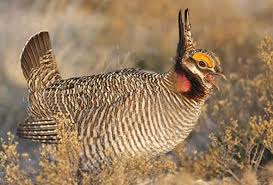
Agricultural News
Oklahoma Efforts Vital to Three-Year Conservation Strategy for Lesser Prairie-Chicken
Thu, 28 Apr 2016 17:52:48 CDT
 The U.S. Department of Agriculture (USDA) announced Thursday the release of a three-year conservation strategy that will guide the voluntary restoration of 500,000 acres of habitat for the lesser prairie-chicken, an iconic grassland bird of the southern Great Plains. The bird has historically suffered from population declines, and this strategy is part of an ongoing science-based strategic effort by USDA's Natural Resources Conservation Service (NRCS) to restore grassland and prairie ecosystems while enhancing grazing lands in five states. Historic lesser prairie-chicken habitat in Oklahoma extends from the central region through the panhandle.
The U.S. Department of Agriculture (USDA) announced Thursday the release of a three-year conservation strategy that will guide the voluntary restoration of 500,000 acres of habitat for the lesser prairie-chicken, an iconic grassland bird of the southern Great Plains. The bird has historically suffered from population declines, and this strategy is part of an ongoing science-based strategic effort by USDA's Natural Resources Conservation Service (NRCS) to restore grassland and prairie ecosystems while enhancing grazing lands in five states. Historic lesser prairie-chicken habitat in Oklahoma extends from the central region through the panhandle.
"Across the country, we're seeing firsthand how farmers, ranchers and forest landowners are voluntarily stepping forward to aid wildlife species," said Gary O'Neill, NRCS state conservationist in Oklahoma. "By adopting conservation systems, agricultural producers in Oklahoma can restore top-notch lesser prairie-chicken habitat while also making working lands more productive and resilient to wildfire and climatic extremes."
Through the Lesser Prairie-Chicken Initiative (LPCI), part of the agency's Working Lands for Wildlife (WLFW) partnership, LPCI has conserved more than 1 million acres of high-quality habitat in Oklahoma, Colorado, Kansas, New Mexico and Texas since 2010.
By the end of 2018, this strategy will guide the restoration of another half-million acres by focusing on five key threats to the bird degraded rangeland health, invasive redcedar trees and mesquite, cultivation of grazing lands and lack of fire in grassland habitats. In Oklahoma, NRCS will work with farmers and ranchers to address these threats by implementing prescribed grazing plans, removing invasive eastern redcedar and conducting prescribed burns.
This strategy also aligns with ongoing efforts of the Western Association of Fish and Wildlife Agencies and other conservation partners throughout the lesser prairie-chicken range.
Research and experience gained through ongoing conservation efforts guide the focus for restoring and protecting lesser prairie-chicken habitat. For example, a recent study found the birds avoid redcedar trees by placing their nests at least 1,000 feet from the nearest tree, and that they stop using grasslands altogether when tree density reaches three trees per acre.
The prairie and grassland ecosystems of the southern Great Plains evolved through the interaction of fire and grazing large animals such as bison. By introducing fire and sustainable ranching practices and removing invasive woody species, ranchers are mimicking historic conditions on Great Plains ecosystems and improving habitat for lesser prairie-chickens while at the same time minimizing risks of catastrophic wildfires.
With about 95 percent of the lesser prairie-chicken's range under private ownership, voluntary conservation is key to benefitting the species and its habitat. The bird is no longer listed as a threatened species under the Endangered Species Act after a court vacated the March 2014 designation by the U.S. Fish and Wildlife Service (FWS).
"NRCS remains firmly committed to promoting and delivering long-term conservation of the working grassland ecosystems that the species requires," O'Neill said. "In this report, we lay out our renewed commitment to this partnership through 2018, the life of the Farm Bill, and demonstrate the effectiveness these investments can have in bringing back lesser prairie-chicken populations while improving agricultural operations."
NRCS provides technical and financial assistance to ranchers who want to adopt conservation systems that address threats to and conserve lesser prairie-chicken habitat. To learn more about assistance opportunities, ranchers should contact their local USDA service center.
Habitat restoration efforts on private lands are helping species recover across the country. Earlier this year, the FWS delisted the Louisiana black bear because of the species' recovery on bottomland hardwood forests restored by Louisiana landowners. In 2015, the FWS determined listings were not needed for the greater sage-grouse, Bi-State sage-grouse and New England cottontail largely because of large-scale collaborative conservation efforts on private lands.
Since 2009, USDA has invested more than $29 billion to help producers make conservation improvements, working with as many as 500,000 farmers, ranchers and landowners to protect land and water on over 400 million acres nationwide. For an interactive look at USDA's work in conservation and forestry over the course of this Administration, visit USDA Results: Caring for our Air, Land and Water.
WebReadyTM Powered by WireReady® NSI
Top Agricultural News
More Headlines...



















